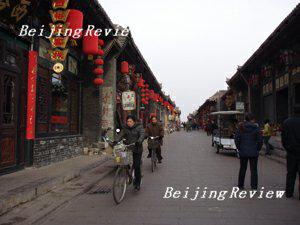An Ancient Town Awakens
2006-12-11FENGJIANHUA
FENG JIANHUA
World heritage sites such as Pingyao are facing the dilemma of how to balance preservation and commercialization

PICTURE OF THE PAST: One can get a glimpse of ancient China in Pingyao
Travel southwest from Beijing, and after about 10 hours on the train and coach, youll arrive at Pingyao, an old town in Shanxi Province.
Nine years ago it was designated as a world heritage site. Visitors have since poured into Pingyao, waking up a town that slept for thousands of years.
The masses have brought jobs for the locals, but are also awakening concerns about protecting the old town amid the sudden influx of tourists and the wildfire growth of tourism-related businesses.
On a recent visit to Pingyao, this reporter took a coach that was required to park outside the town so as not to worsen traffic conditions in the old city.
Pingyao began building a city wall as early as the eighth century B.C., but the wall seen today was mainly built around the 1370s. About 10 meters high and 12 km in total length, it is one of the best-preserved brick-and-stone city walls in China today.
The wall, stuffed with clay and covered with bricks and stones, roughly takes the shape of a square that encloses the town. The east, west and north sections run straight, while the south section wends its way along the riverbank. The wall has six gates, the towns only entrances.
Profiting from the boom
Upon entering the town from the west gate, it seems as if a whole new world is unfolding. Old-fashioned houses and stores line a street paved with grayish flagstones, a sharp contrast to the modern buildings outside the old town.
Were it not for the motorbikes and cars that occasionally pass by, the feeling would be one of wandering in a hinterland town during feudal times. In the winter months, with cold weather and few tourists, the town is almost empty.
As Pingyao is known nationwide for its beef products, shopping for dried beef before returning home is standard practice for domestic tourists, who can be seen walking around the town, carrying bags of the meat under their arms.
Most of the peddlers we encountered were rural residents from villages near the town or unemployed locals. The booming tourism industry has brought with it business opportunities. Some Pingyao residents have become taxi drivers, while others have opened small restaurants featuring rural dishes or stores selling local products.
“If you work hard, youll have no problem supporting a family,” said pedicab driver Zhang Daqing. Zhang, 32, is the father of two school-age children. He came to Pingyao from his nearby home village a few years ago, and began making a living in the textile business.
However, when Pingyaos textile industry shrank, Zhang went bankrupt. He then began to earn a living by taking tourists around the town on his tricycle. He said the manual work suits him, as it doesnt require a big investment and involves little risk.
While pedaling hard on his tricycle, Zhang kept talking to us about the ancient town. “Touring the town on my tricycle, youll enjoy not only fresh air but also a free tour guide service,” he said jokingly. “Its good value for your money.”
Zhang was optimistic about the future, saying that tourism is bound to develop rapidly in this world cultural heritage town. “Anyone with business sense has a good chance to get rich,” he said, adding that he was thinking of developing a more lucrative business than riding a tricycle, which he said was his temporary means of earning a living.
It is Pingyaos world cultural heritage status that makes him confident, he said.
Wang Jinhai shares this positive outlook. The 43-year-old Pingyao native has been a taxi driver for more than 15 years. In the beginning, he drove a minibus. As there were few tourists in the town and most locals couldnt afford to take a taxi, Wang could barely make ends meet for a family of four.
Recently, however, Wangs taxi business has received a notable boost with an increasing number of tourists visiting Pingyao. “We taxi drivers now have greater motivation than before,” he said. “Work hard, and youll make money.”
Early last year, Wang sold his old minibus and bought a small car for about 30,000 yuan. “A car is more attractive to tourists and can cater better to their needs,” he said. “Who wants to tour around the town by minibus?”
Tourism woes

WILD RIDE: Many people in Pingyao, like this rickshaw driver, are benefitting from the towns tourism boom
Unlike the young people, 69-year-old Zhao Changben has mixed feelings about Pingyaos prosperity. A native of Pingyao, Zhao lived in the town proper until three years ago, when he moved to a new residential quarter on the outskirts. However, he often revisits his old home.
Zhao used to work with the towns cultural relic protection department. After retirement, he devoted himself to the study of Pingyaos culture. He is an eyewitness to Pingyaos development, as well as a participant in its ancient culture preservation program.
According to Zhao, Pingyao was a rich commercial town in the old days and the birthplace of Chinas financial industry. At its height, the town was one of the centers of gravity for Chinas economy. However, since the early 1950s, the lack of water has constituted a severe bottleneck for its further development.
Today, the drinking water in the town is pumped in from 20 km away through an underground pipe. As a result, it is impossible for Pingyao to become an industrialized town. While neighboring regions are prospering in the industrialization drive, factories in Pingyao have been forced to move elsewhere. “Pingyaos decline should be attributed to the unfavorable natural environment to a large extent,” Zhao said grimly.
Though it lags behind in industrial development, Pingyao has been able to preserve its ancient features, a great comfort to Zhao. He said the past five years have seen “unprecedented development” in Pingyao, and he thinks that tourism holds the key to the towns future development. Without the UNESCO recognition, all this would have been impossible, he said.
At the same time, Zhao expressed concern about problems on the heels of the tourist boom. He recalled that when he was young, Pingyao was a quiet, leisurely place. At that time, bikes were rarely seen, let alone cars. Nowadays, however, during peak tourist seasons, the narrow streets are packed with tourists, motorbikes and cars.
However, a more insidious problem than crowds is commercialization, according to Zhao. “Ancient Pingyao was characterized by simplicity. Now the town is becoming more and more flashy,” he said, warning that the trend will damage the overall cultural atmosphere.
Zhao also has reservations about new specialized streets, such as “Curio Street” and “Hotel Street.” According to him, busy streets in ancient Pingyao were all-inclusive. The homogenized streets have distorted Pingyaos traditional business culture, he noted.
Zhao said that protection of the ancient town not only calls for administrative initiatives but also requires special expertise. He therefore called on the local government to give full play to the role of relic protection professionals.
Competing for tourists
Apart from the small shops selling beef, hotels also dot the landscape in this ancient town. Pingyao has only 3,000 residential homes, but at least 300 hotels of varying sizes.
Sun Jinpings hotel, with an investment of 200,000 yuan, opened only a few months ago. As winter isnt the peak season for tourism, the hotel had few guests and the doors of most rooms were closed off.
When we entered, several waitresses were chatting while making dumplings in the corner of the lobby. Catching sight of us, they immediately called out warm greetings.
One room costs 300 yuan a day in the peak season, but was now going for only 80 yuan, said Sun. “Competition in the tourism industry is too fierce,” he mused. “It isnt easy to stay afloat.”
Sun said he could do nothing but pin his hopes on the coming tourist rush in three months. According to Sun, there are four peak seasons a year, each of which lasts from seven to 15 days. Whether his hotel can earn money or not depends on these periods, Sun said, adding that during low seasons its fine as long as the hotel does not lose money.
Among Pingyaos many hotels, Tianyuankui Hotel, located on a busy commercial street, is most popular with foreign tourists.
Zhang Xiaojun, 25, began to work at the hotel when he graduated from a junior college as an English major last July. He said the hotel has about 60 beds, offers Western food and broadband Internet access, and can accommodate groups and gatherings.
Despite the daunting competition, Zhang said he considered the hotel business to have a promising future given Pingyaos tourism takeoff. With the ambition to open a hotel of his own in Pingyao, Zhang has tied his fate to the ancient town, even though he wasnt born there.
